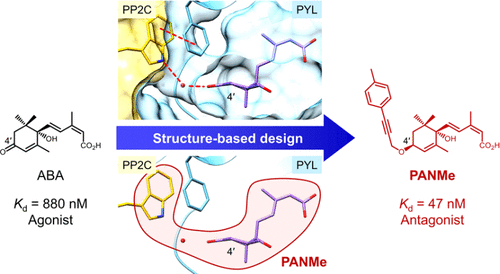当前位置:
X-MOL 学术
›
ACS Chem. Biol.
›
论文详情
Our official English website, www.x-mol.net, welcomes your feedback! (Note: you will need to create a separate account there.)
Structure-Based Chemical Design of Abscisic Acid Antagonists That Block PYL–PP2C Receptor Interactions
ACS Chemical Biology ( IF 4 ) Pub Date : 2018-04-05 00:00:00 , DOI: 10.1021/acschembio.8b00105 Jun Takeuchi 1 , Naoki Mimura 2 , Masanori Okamoto 3, 4 , Shunsuke Yajima 5 , Masayuki Sue 6 , Tomonori Akiyama 6 , Keina Monda 7 , Koh Iba 7 , Toshiyuki Ohnishi 1, 8 , Yasushi Todoroki 1, 8
ACS Chemical Biology ( IF 4 ) Pub Date : 2018-04-05 00:00:00 , DOI: 10.1021/acschembio.8b00105 Jun Takeuchi 1 , Naoki Mimura 2 , Masanori Okamoto 3, 4 , Shunsuke Yajima 5 , Masayuki Sue 6 , Tomonori Akiyama 6 , Keina Monda 7 , Koh Iba 7 , Toshiyuki Ohnishi 1, 8 , Yasushi Todoroki 1, 8
Affiliation

|
In Arabidopsis, signaling of the stress hormone abscisic acid (ABA) is mediated by PYR/PYL/RCAR receptors (PYLs), which bind to and inhibit group-A protein phosphatases 2C (PP2Cs), the negative regulators of ABA. X-ray structures of several PYL-ABA and PYL-ABA-PP2C complexes have revealed that a conserved tryptophan in PP2Cs is inserted into a small tunnel adjacent to the C4′ of ABA in the PYL-ABA complex and plays a crucial role in the formation and stabilization of the PYL-ABA-PP2C complex. Here, 4′-modified ABA analogues were designed to prevent the insertion of the tryptophan into the tunnel adjacent to the C4′ of ABA in these complexes. These analogues were predicted to block PYL–PP2C receptor interactions and thus block ABA signaling. To test this, 4′-O-phenylpropynyl ABA analogues were synthesized as novel PYL antagonists (PANs). Structural, thermodynamic, biochemical, and physiological studies demonstrated that PANs completely abolished ABA-induced PYL–PP2C interactions in vitro and suppressed stress-induced ABA responses in vivo more strongly than did 3′-hexylsulfanyl-ABA (AS6), a PYL antagonist we developed previously. The PANs and AS6 antagonized the effects of ABA to different degrees in different plants, suggesting that these PANs can function as chemical scalpels to dissect the complicated regulatory mechanism of ABA signaling in plants.
中文翻译:

脱落酸拮抗剂的基于结构的化学设计,可阻断PYL–PP2C受体的相互作用
在拟南芥中,胁迫激素脱落酸(ABA)的信号传导由PYR / PYL / RCAR受体(PYLs)介导,该受体与ABA负调节剂A组蛋白磷酸酶2C(PP2Cs)结合并抑制A组蛋白磷酸酶2C(PP2Cs)。几种PYL-ABA和PYL-ABA-PP2C配合物的X射线结构表明,PP2Cs中一个保守的色氨酸被插入到一条与PYL-ABA配合物中ABA C4'相邻的小通道中,并在其中起着至关重要的作用。 PYL-ABA-PP2C配合物的形成和稳定化。在此,设计了4'-修饰的ABA类似物以防止色氨酸插入这些复合物中与ABA C4'相邻的通道中。预计这些类似物会阻断PYL-PP2C受体的相互作用,从而阻断ABA信号传导。为了测试这一点,4'- O-苯基丙炔基ABA类似物被合成为新型的PYL拮抗剂(PANs)。结构,热力学,生物化学和生理学研究表明,PANs在体外完全消除了ABA诱导的PYL-PP2C相互作用,并且比3YL-己基硫烷基-ABA(AS6)(我们的PYL拮抗剂)更强地抑制了体内的应激诱导的ABA反应。以前开发的。PANs和AS6在不同植物中拮抗ABA的作用程度不同,表明这些PANs可以作为化学解剖刀来解剖植物中ABA信号转导的复杂调控机制。
更新日期:2018-04-05
中文翻译:

脱落酸拮抗剂的基于结构的化学设计,可阻断PYL–PP2C受体的相互作用
在拟南芥中,胁迫激素脱落酸(ABA)的信号传导由PYR / PYL / RCAR受体(PYLs)介导,该受体与ABA负调节剂A组蛋白磷酸酶2C(PP2Cs)结合并抑制A组蛋白磷酸酶2C(PP2Cs)。几种PYL-ABA和PYL-ABA-PP2C配合物的X射线结构表明,PP2Cs中一个保守的色氨酸被插入到一条与PYL-ABA配合物中ABA C4'相邻的小通道中,并在其中起着至关重要的作用。 PYL-ABA-PP2C配合物的形成和稳定化。在此,设计了4'-修饰的ABA类似物以防止色氨酸插入这些复合物中与ABA C4'相邻的通道中。预计这些类似物会阻断PYL-PP2C受体的相互作用,从而阻断ABA信号传导。为了测试这一点,4'- O-苯基丙炔基ABA类似物被合成为新型的PYL拮抗剂(PANs)。结构,热力学,生物化学和生理学研究表明,PANs在体外完全消除了ABA诱导的PYL-PP2C相互作用,并且比3YL-己基硫烷基-ABA(AS6)(我们的PYL拮抗剂)更强地抑制了体内的应激诱导的ABA反应。以前开发的。PANs和AS6在不同植物中拮抗ABA的作用程度不同,表明这些PANs可以作为化学解剖刀来解剖植物中ABA信号转导的复杂调控机制。



























 京公网安备 11010802027423号
京公网安备 11010802027423号